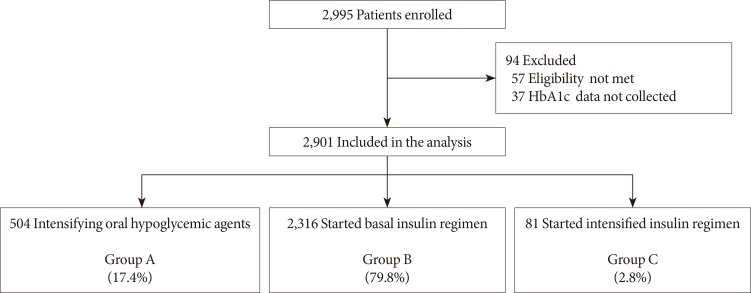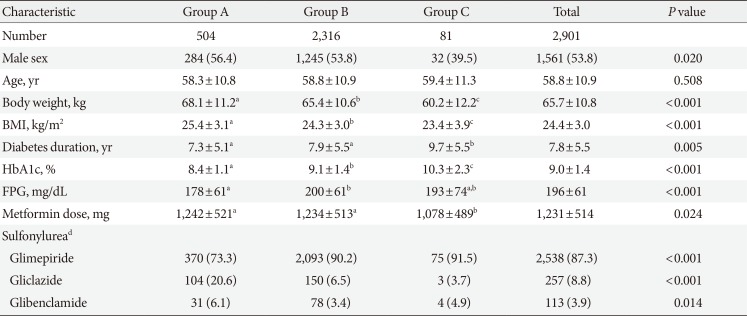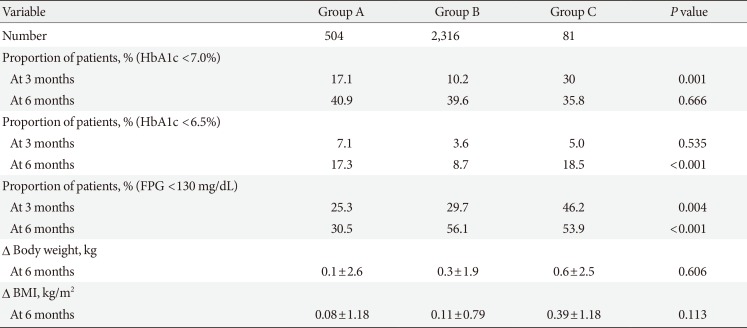ACKNOWLEDGMENTS
The authors also acknowledge all of the following investigators of the MOHAS study: Bong-Ki Jung (Choonchun Kangnam Hospital), Bong-Nam Che (Chae Bong-Nam's Internal Medicine Clinic), Byung-Jun Yoo (Yoo Byung Jun's Internal Medicine Clinic), Chang-Min Woo (Gimchun Medical Center), Chang-Ok Yoon (Yoon Chang Ok's Internal Medicine Clinic), Chang-Rae Cho (Jinhae Yonsei Hospital), Chang-Woo Yoo (Jeonju St. Mary's Hospital), Chang-Yung Ha (Myongji St. Mary's Hospital), Chan-Woo Lee (Pohang St. Mary's Hospital), Chul-Hee Park (Echon Medical Center), Chul-Min Kang (Kang Chul-Min's Internal Medicine Clinic), Do-Hyun Jang (Jang Pyunhan Internal Medicine Clinic), Dong-Chae Lee (Seoul Litz Internal Medicine Clinic), Dong-Seop Choi (Korea University Anam Hospital), Dong-Wan Kim (Gimhae Centum Hospital), Duk-Yung Lee (Hayang Joongang Internal Medicine Clinic), Ee-Chul Shin (21st Century Internal Medicine Clinic), Eun-Hee Cho (Kangwon National University Hospital), Eun-Kyung Byun (SAM Medical Center), Eun-Yung Lee (Na Eun Hospital), Gyu-Yeop Hwang (Gongju Hyundae Hospital), Hae-Dong Park (Geoje Baik Hospital), Hee-Kwon Ahn (Ahn Hee-Kwon's Internal Medicine Clinic), Heung-Sun Yoo (Gimhae Samsung Hospital), Ho-Joon Jo (J Internal Medicine Clinic), Hong-Joon Ahn (Ahn Hong-Joon's Internal Medicine Clinic), Hong-Suk Kim (Seran Sungshim Clinic), Hong-Yul Kim (Kim Hong-Yul's Internal Medicine Clinic), Hun-Kwan Lim (Woori Internal Medicine Clinic), Hwa-Jong Park (Espero Internal Medicine Clinic), Hwan-Suk Choi (Choi Hwan-Suk's Internal Medicine Clinic), Hyo-I Jun (Seoul Family Medicine Clinic), Hyo-Suk Kim (Daegu Medical Center), Hyuk-Soo Sohn (Sungju Hyeseong Hospital), Hyun Choi (Yulin Internal Medicine Clinic), Hyun-Dae Cho (Hwamyeong Hansol Hospital), Hyung-Han Moon (Moon Hyung-Han's Internal Medicine Clinic), Hyun-Joo Jang (Hyundai Hospital), Hyun-Seung Kim (Medi Hill Hospital), Ie-Byung Park (Gachon University Gil Medical Center), In-Hwan Yoo (Yoo's Internal Medicine Clinic), In-Won Kim (Sejin Internal Medicine Clinic), Jae-Hong Kim (Haedong Internal Medicine Clinic), Jae-Hoon Jun (Jun Jae-Hoon's Internal Medicine Clinic), Jae-Il Lee (Lee Jae-Il's Internal Medicine Clinic), Jae-Myung Yu (Hallym University Hangang Sacred Heart Hospital), Jee-Young Oh (Ewha Womans University Mokdong Hospital), Je-Ryong Lee (Lee Je-Ryong's Family Medicine Clinic), Jin-Ah Park (Metro Hospital), Jin-Hyun Choi (Choi Jin-Hyun's Internal Medicine Clinic), Jin-Sung Kim (Seoul Internal Medicine Clinic), Ji-Oh Mok (Soon Chun Hyang University Bucheon Hospital), Jong-Ho Park (Bangbae Jeil Hospital), Jong-Hoon Kim (Dangjin St. Mary's Internal Medicine Clinic), Jong-Hyung Kim (Cheongshim International Medical Center), Jong-Ryeal Hahm (Gyeongsang National University Hospital), Joo-Chul Kim (Dongsuwon Hospital), Joo-Ho Kim (Kim Joo-Ho's Internal Medicine Clinic), Joon-Ki Yeo (Yeo Joon-Ki's Internal Medicine Clinic), Joon-Sang Yoo (Yoo Joon-Sang's Family Medicine Clinic), Jung-Eun Seo (Yujin Internal Medicine Clinic), Jung-Han Kim (Sungae Hospital), Jung-Hoon Sung (Semyung Internal Medicine Clinic), Jung-Ik Woo (Yonsei Home Clinic), Jung-Pil Park (e-Joeun Joongang Hospital), Ki-Duk Kim (Chungkoo Jeil Internal Medicine Clinic), Ki-Young Kim (Kim Ki-Young's Internal Medicine Clinic), Kwang-Jae Lee (Daedong Hospital), Kwang-Min Pyo (Pyo Kwang-Min's Internal Medicine Clinic), Kwang-Soo Cha (Cha Kwang-Soo's Internal Medicine Clinic), Kwan-Hyung Lee (Hyundai Yunhap Internal Medicine Clinic), Kyo-Sun Kim (Kim Kyo-Sun's Internal Medicine Clinic), Kyoung-Ah Kim (Dongguk University Ilsan Hospital), Mi-Ae Cho (Dong Rae Bong Seng Hospital), Mi-Jung Kim (Pureun Mirae Internal Medicine Clinic), Mi-Kyung Kim (Baptist Hospital), Min-Ah Nah (Busan Medical Center), Min-Seop Song (Seoul Song Internal Medicine Clinic), Myung-Choon Lee (Lee's Family Medicine Clinic), Nam-Jin Yoo (Gunsan Medical Center), Nam-Yung Kang (Kang Nam-Yung's Internal Medicine Clinic), O-Yoon Kwon (Kwon O-Yoon's Internal Medicine Clinic), Sang-Ho Jang (Yonsei Internal Medicine Clinic), Sang-Ho Lee (Daejeon Hankook Hospital), Sang-Hyun Joo (Boomin Hospital), Sang-Yong Lee (Heerak Seoul Family Medicine Clinic), Se-Chang Oh (Songdo Hospital), Se-Hee Kim (Jungdong Hospital), Se-In Hong (Kwangjoo Bohoon Hospital), Seok-O Park (Kwangmyung Sungae Hospital), Seok-Woo Kang (Seoul Red Cross Hospital), Seung-Hoon Lee (Dongjak Kyunghee Hospital), Seung-Hyun Lee (Yeungnam University Yeongcheon Hospital), Shin-Eung Kim (Kim Shin-Eung's Internal Medicine Clinic), Soo-Min Nam (Daejeon Sun Hospital), Suk-Joo Ahn (Ahn Suk-Joo's Internal Medicine Clinic), Sung-Chil Kim (Kim's Internal Medicine Clinic), Sung-Ho Kwon (Gangnam Donggang Hospital), Sung-Koo Kang (Suwon Hankook Hospital), Sung-Kwan Hong (Seoul Endo Internal Medicine Clinic), Sung-Soo Park (Park Sung-Soo's Internal Medicine Clinic), Sun-Hwa Lee (Incheon Christian Hospital), Tae-Kyung Kwon (Kijang Hospital), Tae-Wook Park (Chunan Choongmoo Hospital), Won-Shik Shin (Kangseo Jeil Hospital), Won-Taek Jung (Kijang Korea Clinic), Yoon-Ho Kim (Kim Yoon-Ho's Internal Medicine Clinic), Yoon-Ja Kim (Hyundai Internal Medicine Clinic), Yoon-Jeong Do (Raphael Internal Medicine Clinic), Yun Lee (Seoul Metropolitan Bukbu Geriatric Hospital), Yung-Chan Kang (Kang Yung-Chan's Family Medicine Clinic), Yung-Chan Kim (Chungdam Anse Hospital), Yung-Chul Cho (Patima Yunhap Internal Medicine Clinic), Yung-Do Suh (Suh Yung-Do's Internal Medicine Clinic), Yung-Geun Choi (Joeun Samsun Hospital), Yung-Jae Ko (Good Morning Internal Medicine Clinic), Yung-Joo Choi (Huh's Internal Medicine Clinic), Yung-Joon Kim (Kim Yung-Joon's Internal Medicine Clinic), Keun-Young Park, Dong-Mee Lim (Konyang University Hospital), Ki-Rak Park, Choon-Shik Lee (Gyeongjoo Internal Medicine Clinic), Ho-Yeon Chung, Kyu-Jeung Ahn, Gyu-Cheol Hwang (Kyung Hee University Hospital at Gangdong), Keun-Gyu Park, Hye-Soon Kim (Keimyung University Dongsan Medical Center), Duk-Kyu Kim, Mi-Kyoung Park, Ja-Won Kim (Dong-A University Hospital), Mi-Kyung Kim, Ji-Hye Suk (Maryknoll Hospital), Jong-Eun Park, Chan-Gyu Park (Park's Internal Medicine Clinic), Jeong-Hyun Park, Min-Jeong Kwon (Inje University Busan Paik Hospital), Yong-Wook Cho, Seok-Won Park, Soo-Kyoung Kim (CHA Bundang Medical Center, CHA University), Kyung-Soo Ko, Byung-Doo Lee (Inje University Sanggye Paik Hospital), Kun-Ho Yoon, Hun-Sung Kim, Seung-Hwan Lee, Yoon-Hee Choi (Seoul St. Mary's Hospital, College of Medicine, The Catholic University of Korea), Yung-Sook Nah, Ji-Ho Noh (Sokcho Medical Center), Yoon-Ee Kim, Bang-Hoon Lee (Seoul Metropolitan Dongbu Hospital), Hee-Kyung Kim, Sung-Won Park (Andong Hospital), Ji-Hye Kim, Sun-Kyung Song (Yesu Hospital), Young-Il Kim, Ilsung Nam-Goong, Eun-Sook Kim (Ulsan University Hospital), Kwang-Seop Lee, Sang-Woon Lee (Lee's Internal Medicine Clinic), Sung-Dae Moon, Je-Ho Han (Incheon St. Mary's Hospital, College of Medicine, The Catholic University of Korea), Dong-Jun Kim, Jung-Hyun Noh (Inje University Ilsan Paik Hospital), Sung-Rae Cho, Gwi-Hwa Jung (Changwon Fatima Hospital), Dong-Sun Kim, Tae-Wha Kim (Hanyang University Seoul Hospital), and Myung Bae, Dong-Hoon Shin (Hanil Hospital).








 PDF
PDF ePub
ePub Citation
Citation Print
Print



 XML Download
XML Download